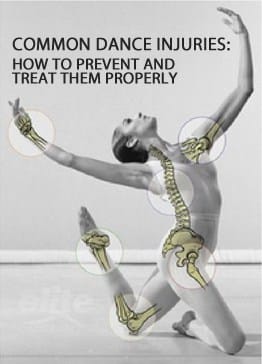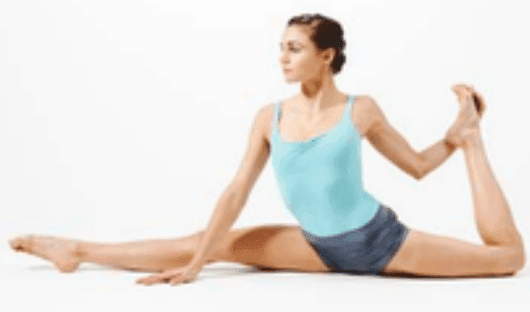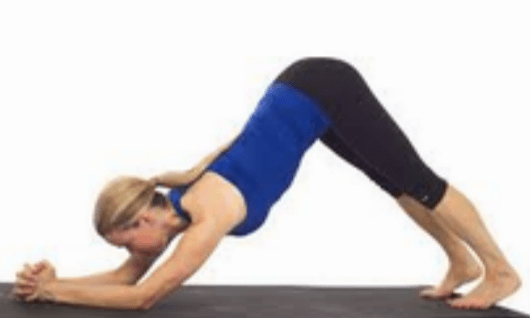
Dancers, like any other athlete, put their blood, sweat and tears into their work. Rehearsing for hours and hours to get the choreography just right takes a toll on the body and on the mind. Being informed of the common injuries, how to prevent them and how to treat them when they do arise are all key components to stay a happy and healthy dancer.
Common Dance Injuries
The constant use, overuse, and repetition of certain muscles is the main cause for dance injuries. A major cause of knee injuries is a common diagnosis for dancers called the “overuse” injury. A common “overuse” injury is the jumpers knee or patellar tendonitis which is the inflammation of the tendon from the bottom of the kneecap to the lower leg bone.
Repetition is another cause for knee pain and injury. Certain steps, especially in ballet use the knees by constantly bending (pilé) or jumping (sauté) on hard surfaces. Ballet dancers also overextend their turnout, striving for perfect clean lines and incredible flexibility. Over extending a turnout or forced turnout is when a dancer turns their feet outward beyond their reach of flexibility in their hips causing strain on their knees.
Any type of dance, however, has the body repeating the same steps and moves that cause the overuse and repetition of specific muscles.
Preventing Dance Injuries
Preventing any dance injuries can be as simple as stretching everyday, great nutrition and adequate rest. Listening to your body is key to prevent any serious injuries like knowing when to take a break or when to start training harder.
Strength training is vital to shape a skilled dancer and to help prevent injury. Strong muscles won’t be injured as much or as fast as fragile and weak muscles. Gaining strength comes from participating in the dance classes themselves, especially ballet but also from outside training.
Core is important for strength especially because its the center of the body controlling how the rest of the body moves. Dancing requires a strong center for balance, control of the body and correct alignment. Without a strong core however, these muscles could be worked too much and be out of line with the body causing various injuries. A strong core won’t over strain the knees, hips or any other body part.
Proper alignment in a dancers body is important to reduce any risk for an injury. For example, a ballet dancer needs to think about correct alignment when at the barre such as making sure the knee is in line with the second toe when bending into a pilé.
Stretch, Stretch, Stretch
Stretching plays a huge role in not only preventing injuries, but in dancing as well. Flexibility is everything to a dancer. It helps with all aspects in dance and in this case, reducing the risk to get hurt. Some helpful tips on stretching:
- Stretch everyday
- Stretch pre- dance class and post- dance class
- Warm up muscles before stretching
- Remember to breathe
- Use proper posture
- Slowly increase the stretch as you go
- Hold each stretch for at least 30 seconds
- Try stretching while doing everyday tasks like checking your e-mail, watching TV, etc.
Along with daily, pre- and post- dance class stretching, yoga is also highly recommended for a dancer. Yoga helps a dancer to:
- Increase flexibility
- Improve balance and circulation
- Help prevent injury
- Strengthen turnout
- Improve concentration and creativity
- Learn breathing techniques
- Reduce stress
- Centers oneself inwards
Elite Sports Club offers various Yoga classes at all five of their locations.
How To Treat Dance Injuries
Unfortunately dance injuries happen. Even though there are many tactics to prevent them, sometimes they can be inevitable. The constant use, overuse, and repetition of certain muscles is the main cause for dance injuries. All dancers love to use the expression, R.I.C.E. as the cure-all be-all of dance injuries. Dancers, like any other athlete, want to get better as soon as they can to get back to what they love. R.I.C.E. is just the ticket. The main goal is to reduce any pain or swelling so the injury doesn’t get any worse and can heal properly.
R.I.C.E.
Rest, Ice, Compression, Elevation
- Rest- This is required for the healing process so the affected area doesn’t strain more than it already has.
- Ice- This helps reduce any pain or swelling that could occur from increased blood flow or blood loss. Some experts say to apply ice for twenty minutes every hour while others say to alternate between ice and no ice every twenty minutes for a 24-48 hour period.
- Compression- Like ice, it helps to reduce swelling caused by the inflammatory process. The most effective is an elastic cloth band, it should be snug but not too snug that the body part can’t move while in the band.
- Elevation- Elevating the injured body part helps the blood circulation it needs to reduce swelling and pain. Make sure you prop it up high enough so that your foot is above your knee.
A combination of all four components will help the healing process and you’ll be ready to hit the dance floor once again. If the injury is more than a sprain or a deep bruise, additional medical treatment should be highly considered, like seeing a Physical Therapist.
Dance takes a particular toll on the body. Physical Therapy can be especially important for dancers who want to keep their body healthy for a long and successful career.
Our S.M.A.R.T. Clinic Physical Therapists are located at all five of Elite Sports Clubs locations. I work out of the River Glen and Mequon locations, and have extensive experience working with dance related injuries and adolescent sports medicine in general. Come ask me a question any time or let me take a look at that nagging injury. We’ll have you back on the dance floor in no time!
Get a free injury assessment!By Kristin Novak, PT, DPT, Physical Therapist for the S.M.A.R.T. Clinic at Elite Sports Clubs


